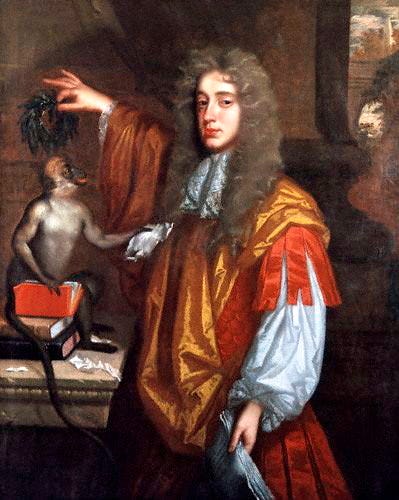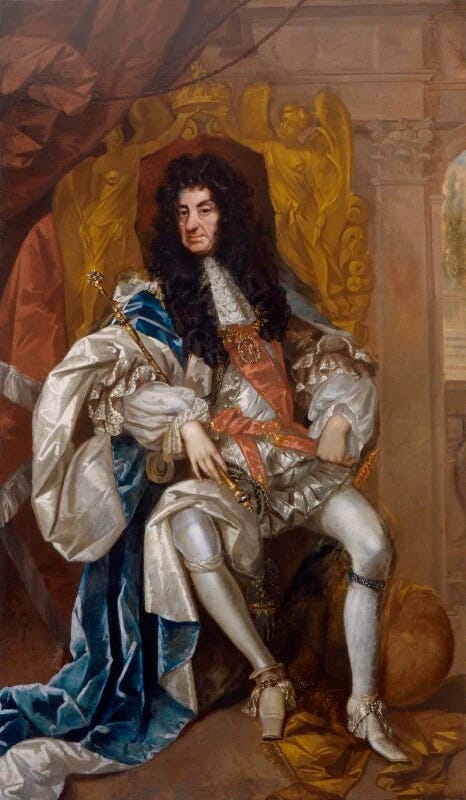At the top of every Rant you receive in your inbox, you see a devilishly clever logo depicting some guy doing something with some monkey holding some book.
Just what the hell is that all about, anyway?
First and foremost, that logo was drawn by my extremely brilliant younger daughter. (Don’t worry, my older daughter and my one-and-only son. I know you’re both extremely brilliant, too!)
Second and more to the point, that guy is a 17th-century British aristocrat named John Wilmot, Second Earl of Rochester (1647-1680).
Now, if there’s someone in British literary history that I know WAY too much about, it’s John Wilmot, Second Earl of Rochester (see A Martyr for Sin). Let me assure you, though, if there was ever someone in British literary history worth knowing way too much about, Rochester is that someone.
Rochester (aristocrats usually were referred to by their titles) was the notorious lead merrymaker in the court of King Charles II (1630-1685)—a king and a court notoriously dedicated to merrymaking. By “merrymaker/merrymaking” I mean these guys were party animals, heavy drinkers, devotees to a range of sexual pleasures and exploits, and—as privileged blue-bloods—flouters of conventional English morality and behavior.
The brotocracy.
Such aristocratic men were known as Rakes (basically, playboys), Wits (clever, sharp-tongued, devil-may-care fellows), Ballers (not hoopsters or sex gods, but star attendees at court galas and balls), and Libertines (not only extreme pleasure-seekers, but intellectual skeptics and iconoclasts).
By far, Rochester was the head honcho Rake-Wit-Baller-Libertine of his day. And, as you can see by his dates, his day was not a long one. He died at the early (and Christ-like) age of 33 from an advanced case of burning the candle at both ends. I recommend a very good (if not altogether historically accurate) 2004 film titled The Libertine where Rochester is portrayed—disturbingly accurately—by none other than Johnny Depp.
Why am I telling you all this stuff about Rochester (other than because I know WAY too much about him)? Two reasons.
Reason One: Rochester had this rakish/witty/sardonic portrait of himself painted by Flemish portraitist Jacob Huysmans. In it, he’s appointing a monkey ripping pages from a book as Poet Laureate of England. The laurel wreath Rochester holds above the little beast’s head signifies this great literary honor. Perhaps the look Rochester gives us can be described as one of wry disdain. Meanwhile, Rochester holds in his other hand a sheaf of, likely, his own writings.
Reason Two: Because—as maybe you’ve already surmised—Rochester really knew how to Rant Against the Regime.
Seeing the connection?
Specifically, Rochester knew how to Rant against the early modern Regime of Charles II.
At this point, I could go into a lengthy discussion of the early modern period and the regime of Charles II. Again, both are things I know WAY too much about. Instead, I’ll supply you with a touch of necessary context. Even that backstory will take some telling, so please bear with me.
The “early modern period” in Western Europe is seen as an age of transition between medieval and modern times. Because this shift happened at different moments and in various ways across Europe, a broad and imprecise timeframe of 1450-1800 is given to the period. Generally, however, the changeover involves the decline of feudalism and the rise of mercantilism and then industrial capitalism as the dominant economic system. Accompanying this alteration of the economic base of European society is a radical makeover of Europe’s cultural superstructure. Namely, the weakening of monarchy and the rise of representative government, usually in some form of republic and always at odds with the aristocratic establishment.
In short, the early modern period is the beginning of us—by and large who we are and what we do in modern Western culture.
The regime of Charles II came at an extreme flashpoint in this medieval-to-modern transition in England. Charles II’s father, Charles I, fought the English Civil War (1642-1651) against the forces of republican modernization. For his trouble, Charles I was captured, put on trial, and publicly beheaded in 1649. Crucially, however, Charles II was not crowned successor until 1660. Thus, for that decade or so in between, there was no monarchy in England. Instead, a republic known as the English Commonwealth governed the realm with Oliver Cromwell (1599-1658) as the “Lord Protector” of England.
In short, the English world had been turned upside down.
After Cromwell died the Commonwealth could not hold together. To make a long history short, a compromise was reached by the movers and shakers of the day to bring back the monarchy. This event is known as The Restoration. In 1660, Charles II was brought back from exile and crowned King. However, the throne Charles II inherited was far different than the throne sat upon by his father.
Charles I ruled over a crumbling medieval political-economic structure; Charles II found himself ruling over an emerging early modern state.
The biggest change was Charles having to contend with a newly powerful House of Commons in the English Parliament. Hitherto, the House of Lords, filled by powerful aristocrats, dominated Parliament. After the upheaval of the Civil War and the Commonwealth, however, the non-aristocratic Commoners elected to be MPs (Members of Parliament) in the House of Commons came to hold greater sway. Moreover, these MPs tended to be rich landowners and businessmen who wanted a bigger slice of the British wealth pie—that is, all the money and power previously gobbled up by aristocrats.
As a result of all this mayhem and realignment, Charles found himself needing to navigate, for the first time in English affairs of state, the modern innovation of political parties. Specifically, two dominant factions vied for power, the Tories (conservative, pro-monarchy, centered in the House of Lords) versus the Whigs (progressive, pro-commerce, centered in the House of Commons).
Welcome to modern politics.
How did Charles deal with this new world order? He did what most modern politicians do nowadays. He lied his ass off. He played factions off one another. He said he would do one thing then did another. When Parliament wouldn’t vote him enough funds, he took secret money from his cousin, Louis XIV of France. In short, he wheeled-and-dealed shamelessly (and often successfully) on the political front while womanizing endlessly and openly on the social front (a habit that often got him into political hot water).
To give you a taste of who Charles was, here’s a portrait of him peacocking in his fifties. As we’re supposed to notice, he’s showing a lot of leg (Charles was tall, athletic, and notoriously proud of his shapely legs) and he fancies himself holding kingly power by virtue of two comely, bare-bosomed angels holding the Crown above his head.
Behold the Early Modern Monarch. Decking himself out in all the splendor and symbolism of medieval power and pleasure while having those very privileges yanked out from under him by modern political maneuvering.
And Rochester was there with a ringside seat to witness—and Rant Against—this early modern circus.
Rochester is one of the most insightful and scathing satirists of the early modern period. In my estimation, he’s right up there with Jonathan Swift. He didn’t live long enough to leave behind an extensive body of work. But what he did produce hits hard.
His most ambitious piece is a long verse satire titled A Satire Against Reason and Mankind (1674-ish). As the title signals, Rochester critiques first human reason and then human behavior.
As for our use of Reason, Rochester’s narrator asserts that animals are smarter than we are. Animals stick with their five senses to do what they need to do to survive. Humans, by contrast, apply their reason to concoct all sorts of nonsense—philosophical systems, religious beliefs, laws, governments, moral codes—to make themselves miserable and oppressed. Such a false reasoner is characterized as a “busy puzzling stirrer up of doubt” (line 80).
In particular, these “frantic crowds of thinking Fools” occupy “Those Reverend Bedlams, Colleges and Schools” (lines 82-83). Bedlam is the name of the infamous madhouse in London that, since at least the 15th century, housed the insane. Rochester here suggests that our leading framers of Knowledge—esteemed Academics—are in fact churning out Bullshit.
As a professional academic myself, I cannot entirely disagree.
Sadly—tragically, in fact—only aging and death disabuse us, in Rochester’s view, of these fallacies that have controlled our lives. At our bitter end, we wake up from the prolonged bad dream of false reasoning.
Then old Age and Experience hand in hand,
Lead him to Death, and make him understand,
After a search so painful and so long
That all his life he has been in the wrong.
Huddled in dirt the reasoning Engine lies,
Who was so proud, so witty, and so wise. (lines 25-30)
In our graves we realize, finally, just how very stupid we’ve been. Not only is this some edgy ranting but, more painfully, some bad-ass satiric Yellow Laughter.
As for Mankind, Rochester’s narrator is even more cynical about basic human behavior. All of our false reasoning leads us to be, on the whole, ruthless and self-centered cowards only looking to save our own asses.
Look to the bottom of his vast design,
Wherein man’s wisdom, power, and glory join:
The good he acts, the ill he does endure,
’Tis all from fear, to make himself secure. (lines 153-156)
The society we create, in fact, locks us into this pattern of fear-induced conformity. As Rochester’s narrator puts it, we can’t afford NOT to be knaves—that is, selfish, conniving, evil shitheads.
And honesty’s against all common sense:
Men must be knaves, ’tis in their own defense.
Mankind’s dishonest; if you think it fair
Among known cheats to play upon the square,
You’ll be undone.
Nor can weak truth your reputation save:
The knaves will all agree to call you knave.
Wronged shall he live, insulted o’er, oppressed,
Who dares be less a villain than the rest. (lines 159-167)
To sum up Rochester’s assessment of Mankind, then: most of us “are cowards”; all of us, as a simple matter of self-preservation, “should be knaves” (line 169). If we dare step out of line, we risk social disaster. As a result, the dominant mode of human social interaction is that of a pack of frightened liars, crooks, and grifters vying to out-cheat one another. Or, as Rochester’s narrator encapsulates:
And all the subject matter of debate
Is only: who’s a Knave of the first rate? (lines 172-173)
Needless to say, who are these first-rate knaves going to turn out to be? The rich and the powerful of society, of course. The best liars and cheaters among us will tend to be our leading politicians, captains of industry, spiritual and intellectual and cultural guides, and so forth.
And what, in Rochester’s opinion, will be the ambition of these highly accomplished swindlers?
Power.
These charlatans will work to create, seize, and maintain social power. How? They will:
...devise
False Freedoms, Holy Cheats, and formal Lies
Over their fellow Slaves to tyrannize. (lines 176-178)
Ouch.
No, Rochester does not paint a rosy picture of Reason and Mankind. But neither does he paint a “universal” portrait of all humanity. As I’ve contended elsewhere in my Rants, literature does not exist in a social vacuum. Literature and art (and, well, everything else) owes its creation to its times.
And satire especially is a thoroughgoing creature of its temporal circumstances.
As a member of the ruling class of his day, Rochester inspects and exposes the workings of his own power elite. As a member of the House of Lords and an appointed Gentlemen of the King’s Bedchamber, Rochester had first-hand knowledge of the political situation as well as intimate experience of his King. And he didn’t think highly of either one. In fact, quite likely the “Knave of the first rate” in Rochester’s eyes was Charles II himself.
The Regime that Rochester rants against, then, is Modern Power and the Modern State at their early stages.
The misuse of reason and the tyranny of compliance that Rochester rails against in his satire anticipate exactly the panoptic, prison-like, disciplinary modern state described two centuries later by Foucault. In fact, whenever I teach the satires of Rochester to my students, they’re amazed by how well his depictions of 17th-century English life match their own social experiences and dilemmas.
That’s why John Wilmot, Second Earl of Rochester and his monkey are the logo for my Substack. I see him as the germinal modern Ranter.
As for the subtitle of this post—“Or: Who Is That Monkey With the Guy?”—I think the monkey is John Dryden (1631-1700). Dryden was England’s very first Poet Laureate, awarded that honor by Charles II in 1668. Dryden was given to a certain amount of sycophancy, and he and Rochester certainly did not get along. My guess is that Rochester, among other things, is making fun of both Charles and Dryden with this painting (see “Making Monkeys of Important Men”).
But that’s another story.
COMING IN TWO WEEKS: still making this up as I go along...
AND DON’T FORGET...
Read some provocative fiction. Check out and subscribe to my other Substack newsletter, 2084 Quartet at:
While you’re at it, read some provocative social commentary. Check out and subscribe to this absolute Substack gem as well:









Thank you!